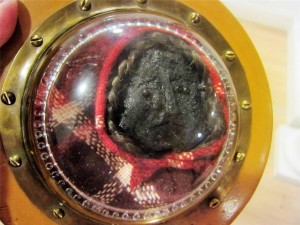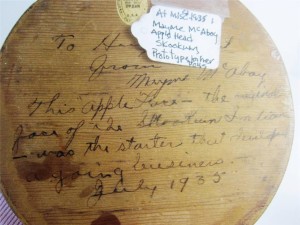 Remarkable rare Skookum doll head by the original founder of the company herself, only one of it’s kind we have ever seen or heard of! Remarkable rare Skookum doll head by the original founder of the company herself, only one of it’s kind we have ever seen or heard of!
From a museum that closed it’s doors years ago in Washington State comes a sealed apple head hand-made by Mary Dwyer McAboy , the designer of the original Skookum doll. Has original tag from the Museum AND McAboy’s own handwritten note on the back, along with Skookum intact label. Note itself is collectible without the doll head!
Circa 1915, later sealed under heavy convex glass & mounted and then given by McAboy with hand-written note to a friend in 1935. All documented on the back!
Quite extraordinary, she says this head was the “prototype head that started the entire Skookum industry” and history. Preserved beautifully because of being protectively sealed, black pin glass eyes, fine hair that looks through the glass like human hair, pieces of original woven Native American style cloth in perfect color and condition. Has original Skookum label on back.
A true piece of doll history, unlikely to ever be anything at all similar found again.
The glass itself is amazing, thick and raised bubble glass style with a swirled twist border that is very elegant. Copper metal border with screws on oak base.Condition is excellent for everything. Glass is VERY reflective; please excuse the white spots which are only caused by camera, not on the actual item.
We are very confident that the provenance is accurate and that this particular head was one of the earliest apple heads that McAboy made herself, then sealed to protect it, then later gave it to her friend as a gift. There certainly may be others that she also framed and preserved, but we’ve never come across one like it.
History:
Mary Dwyer McAboy (1876-1961), of Missoula, Montana learned to carve apple head dolls as a child from her mother.[1] According to an account by McAboy, her mother had sold apple dolls at church socials and sewing circles.[2]
Mary Dwyer had worked as a schoolteacher before marrying Frank E. McAboy in 1909. Her husband died of tuberculosis four years later, in 1913.[3]
Later that year, Mary McAboy began to market apple head dolls dressed in Indian costumes, and achieved rapid commercial success.[4]According to McAboy, her career as a doll maker began when she made an Indian village which she displayed in the window of a grocery store. Vaudeville actress Fritzi Scheff was performing in Missoula at the time, saw the display, and purchased it for “actual money”.[ McAboy duplicated the display, which also sold quickly, and she then began selling increasing numbers of the dolls. She publicized her growing business through western newspapers, and arranged a display at a women’s suffrage office in NY, gaining press coverage there.
She had difficulty processing large numbers of apples, as excessive moisture led to rotting. She consulted with chemists at Montana State Univ in an attempt to control the problem. But demand grew so rapidly that she moved to mass production techniques within a year, and soon almost all of the doll heads were made out of composition.” More pictures are available in our eBay Store Connectibles.
|